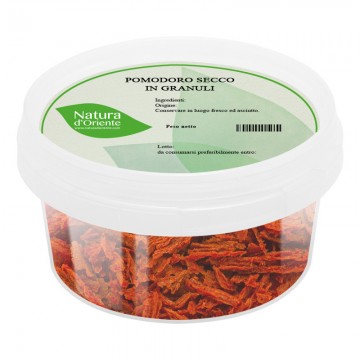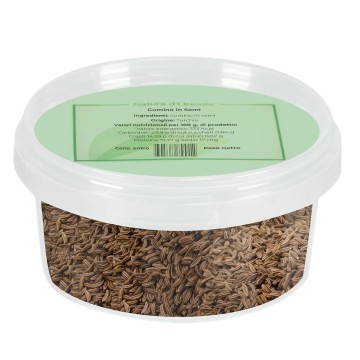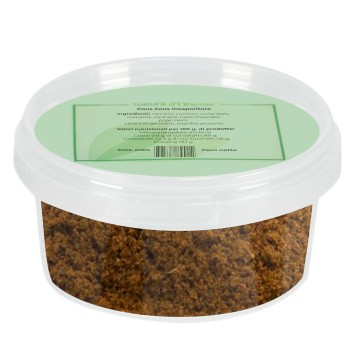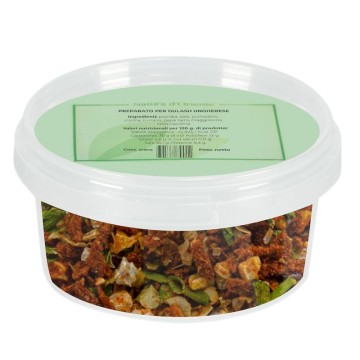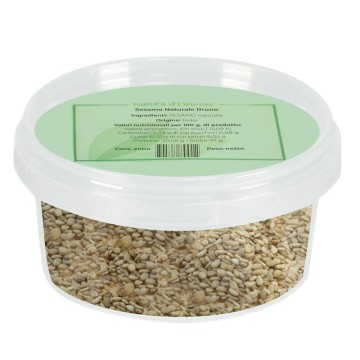The intense flavor of a spice blend from Morocco
Its name in Arabic literally means "chief of the grocery store", which could metaphorically become "the king of spices", because it represents the best of the aromas selected in the bazaars. It was born as a spice mix in North Africa, particularly in Moroccan cuisine, where the many available elements were combined to create an inviting blend on food. Traditionally, Ras el Hanout is made up of 20 to 50 spices, with a combination that can vary from region to region and from home to home. Precisely for this reason, the Ras el Hanout mix on sale is often the result of a proposal between the most common ingredients, which provide the classic pungent, warm and woody flavor - with many elements in harmony with each other. Cinnamon, cloves, pepper and ginger are often added to give notes between sweet and spicy. Other elements such as turmeric, cumin and nutmeg add depth and an intense flavour; nuanced by delicate elements such as rose hips or unusual ones such as anise and cardamom. Although you might think that this North African curry is not spicy, it adds heat to many dishes and complex aromas. Its abundance of spices gives dishes an unusual taste and rich in nuances on the palate, perfect especially in meat and fish dishes.
Does Ras el Hanout have any beneficial properties?
Yes, because the elements that make up the mixture combine the properties of the various spices. Among these are the digestive properties, which also help in eliminating bloating due to intestinal gas. The mixture has a high quantity of antioxidants and minerals such as iron and calcium, beneficial for the body, also representing a source of magnesium and potassium. It contains vitamins such as niacin, thiamine and vitamin A. Its qualities come from typical spices such as cinnamon, turmeric, ginger and nutmeg. Although it is a safe food, excessive consumption of this spice is not recommended since too much spicy food can leave a burning sensation in the mouth and irritate the oral cavity. In addition, consuming too many spices can lead to problems with gastritis, heartburn and gastrointestinal disorders.
What spices does Ras el Hanout consist of?
Our proposal for the mix includes different spices, for a harmonious combination.
Turmeric gives off a warm and slightly spicy flavour, along with bitter notes that make it deep in taste; its intense aroma enhances the pungent tone of Ras el Hanout.
Cloves give a complex taste, sweet and delicate notes, only slightly spicy; its fruity touch and floral aromas balance the more intense spices.
Anise with an unmistakable scent that evokes licorice and its sweet and fresh flavor, is perfect for giving a pleasant spicy touch to meat and fish.
Rosehip infuses a taste between acidulous and sweet fruity, with intense aromatic notes that make this blend more special. Cumin gives a pungent but not excessive flavor, evoking delicate fennel. The warm smell adds slightly toasted notes, which pair well with other deep spices on meat.
Nutmeg gives the blend a warm flavor, pungent notes with a sweetish aftertaste; the citrus nuances mix with cloves and cinnamon.
Cinnamon brings an exotic, pungent and sweetish flavour to the North African blend, with an intense aroma and pleasant peppery notes.
Ginger brings its unique warm and spicy flavour, with fruity and slightly sweet notes; a spicy aroma reminiscent of lemon, pairs well with nutmeg on fish and vegetables.
Long pepper is a slightly less pungent spice than black pepper, with an aroma somewhere between sweet and spicy; it provides sweet floral notes and hints reminiscent of cinnamon and nutmeg.
Cardamom provides a warm flavour and a unique mix of aromatic notes; its balsamic scent evokes delicate and particular scents such as honey, rose and eucalyptus.
Buy our Ras el Hanout
This ready-made mix is not so widespread in supermarkets and is preferably found in specialized spice shops, such as our online shop Natura d'Oriente. You will find a quality selection, ready for seasoning your dishes, with the possibility of purchasing the Ras el Hanout of Morocco with a variable weight. The packages are 50g, 75g, 150g, 100g, 250g, 500g and 1 kg. The Natura d'Oriente purchase and delivery services reserve you an excellent price for the Rasel Hanout and other spices for sale in bulk.
How to use Ras el Hanout in cooking?
Rare in European cuisine, this spice mix is widely used in North African and Moroccan cuisine, which is where we start to talk about its use in gastronomy. Ras el Hanout stands out as a “North African curry” indispensable in many typical dishes of Morocco, Tunisia and Algeria. It is a key ingredient in famous recipes such as the Moroccan tagine (or tagine) based on meat, chicken or fish stew. It is used to season meat stews, dishes such as spicy lamb meatballs and shrimp tagine. It is also used to spicyly flavor couscous, falafel and hummus, and in Moroccan carrot salad. In any case, it is a versatile blend, which can also be used in many local meat and fish dishes. It is sometimes called the “lazy cook’s spice” because it is used on any dish to make it more appetizing.
Tips for using this spice blend in recipes
Ras el Hanout is usually mixed with oil or other hot liquids before adding it to foods. Do not subject the mix to high temperatures or burn it, otherwise it can take on a bitter taste. Add it to dishes in the last 5 minutes of cooking, to enhance their aromas.
Savory recipes: excellent for flavoring vegetables, it adds a touch of extra flavor to raw, steamed or boiled vegetables. Ras el Hanout enhances the flavor of potatoes with pungent notes, and improves the flavor of pumpkin, carrots and cauliflower, before roasting them. This spice blend adds flavour to rice and grain dishes, and is a burst of flavour in couscous and soups. It can be used in gazpacho, a cold Spanish soup made with raw vegetables. It adds an exotic flavour to soft cheeses and vegetarian dishes such as roasted vegetables with chickpeas, feta and herbs. Ras el Hanout can be included in spiced figs, stuffed with soft goat's cheese, honey and chopped walnuts.
Meat and fish: It pairs perfectly with grilled fish, seafood, roasted or steamed fish. It enlivens delicate meats, with a special touch on lamb and chicken, and is generally used in grilled and stewed meats. You can sprinkle this powerful spice blend in beef stews, in stew recipes, on lamb cutlets, on grilled chicken rolls.
Marinades: It can be used in marinades before grilling and in dry rubs (dry rubs for meat) for fish and meat on the barbecue. Its intense flavor makes an excellent marinade for chicken (1 teaspoon of Ras el Hanout, a few tablespoons of olive oil, a crushed garlic clove and a pinch of salt). It pairs very well with garlic, pepper, onion and citrus peel.
Sauces: It is an ingredient that goes well with oil, butter and other emulsifiers to flavor creams, dips and sauces. Delicious for aromatically flavoring a preparation based on Greek yogurt and honey, perfect for vegetables or meat. It can also be added to softened butter or sour cream for a dressing reserved for fish or meat.
Desserts: Although Ras el Hanout is used in savory dishes, it can also flavor some sweets such as cookies, waffles, donuts, apple pie, carrot cake. It infuses a sweet and tangy aromatic note into caramel pudding, yogurt or white kefir, granola or oatmeal. It is a spicy mix that can also be added to drinks such as cider, hot chocolate or zabaglione.
The Recipe: Chicken Salad with Artichokes and Pine Nuts
Ingredients:
4 slices of chicken breast - 5 artichokes - 20 g pine nuts - lemon juice - 1 clove of garlic, minced - oregano - 4 tablespoons of extra virgin olive oil - 4 g of Ras el Hanout - salt and pepper to taste Preparation
Clean the artichokes by removing the top part and removing the tough outer leaves. Cut them into small slices (about half a centimeter) and immerse them in a salad bowl or pan with water and lemon juice. Heat the griddle and cook the artichokes for about 8-10 minutes. Set them aside on a plate and sear the chicken breast slices on the griddle. Remove from the heat and cut the slices into small slices, then put them back on the griddle. At this point, flavor the slices with the Ras el Hanout and let them brown for a couple of minutes. Set aside and prepare a sauce for the chicken salad. Pour the extra virgin olive oil into a bowl, adding the chopped garlic, oregano, pepper, salt and a pinch of Ras el Hanout. Take a large bowl and mix the artichokes, chicken, pinoils. Season with the sauce and serve the chicken salad. If you prefer, garnish with a final sprinkling of Ras el Hanout and accompany with slices of soft bread.
Where does Ras el Hanout come from?
Its original territory is North Africa, where it is commonly associated with Moroccan cuisine, used throughout the Maghreb; although there are some particular versions in Algeria and Tunisia. Its origin is very ancient, as with many spice mixes, and Ras el Hanout was probably born in the large North African markets, among the spice sellers in their bazaars (shops). The word Ras el Hanout, in fact, means "chief of the grocery store". Traditionally, Ras el Hanout is composed of 20 to 50 spices: a traditionally very rich mixture of ingredients, which can change locally, from region to region and according to taste. There are many varieties, depending on the preferences of the most refined preparers and buyers. Each North African family has its own recipe, and each spice seller can create his own unique and refined combination. The classic formulation usually includes about 30 spices including: nutmeg, cinnamon, anise, turmeric, pink pepper, white pepper, long pepper, cubeb pepper, galangal, ginger, allspice, black cardamom, green cardamom, rose buds, cardamom, mace, coriander, grains of paradise, cinnamon, cloves, iris, lavender, belladonna berries, fenugreek, Indian hemp, ash bay, cumin, fennel, garlic. Regarding other spice blends such as Baharat there is a difference. Ras el Hanout contains many similar ingredients, but includes lesser-known and more variable spices.





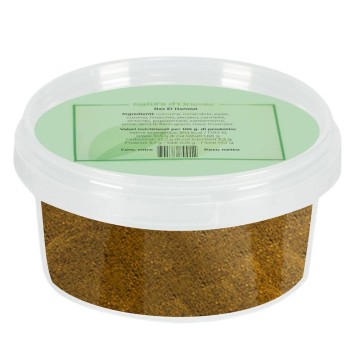



 No reward points for this product.
No reward points for this product.
